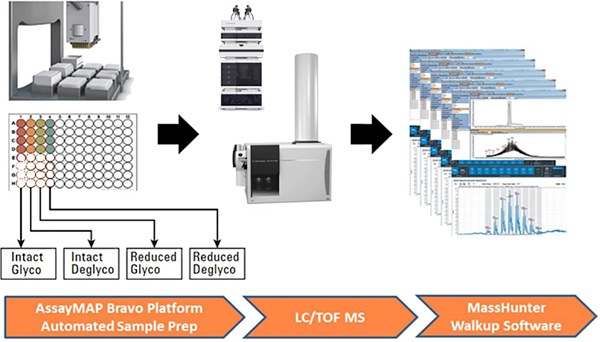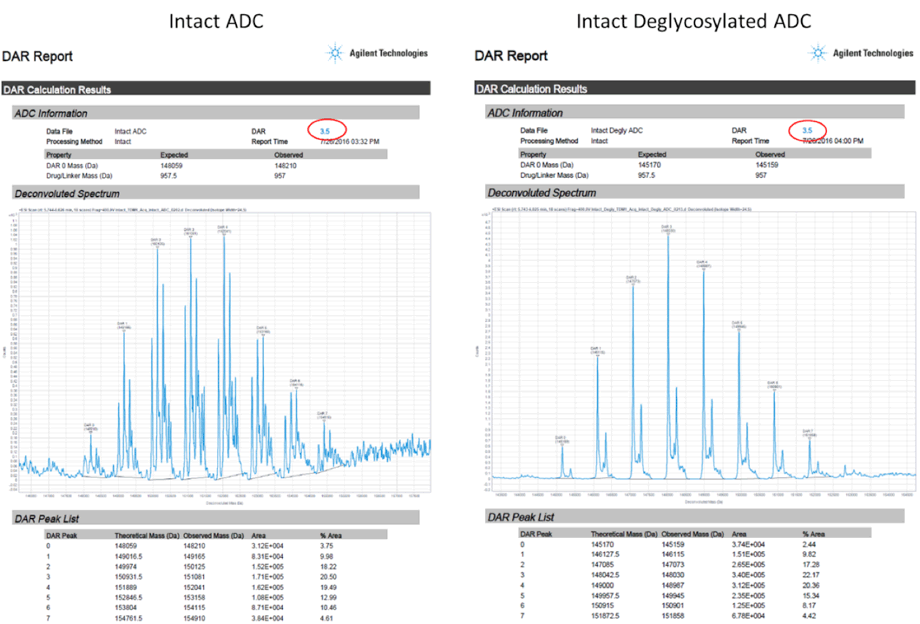Access Agilent eNewsletter November 2016

Integrated workflow simplifies automated calculation of antibody-drug conjugate (ADC) drug-to-antibody ratio (DAR)
David L. Wong
Agilent Sr. Applications Scientist
Tanner Stevenson
Agilent Application Software Engineer
Jing Chen
Agilent LC/MS Scientist
An exciting new approach to generate effective biotherapeutics with minimal side effects is antibody-drug conjugates (ADCs). ADCs represent a new generation of targeted biotherapeutics that make up a rapidly growing segment of the drug discovery pipeline. They are created by attaching potent cytotoxic drugs through a linker to monoclonal antibodies (mAbs) that target specific cells. They deliver those drugs to the desired tissue while limiting toxicity to nontargeted tissues [1].
While the concept of an ADC is relatively straightforward, the analytical work required to fully characterize ADCs is normally quite complex. This article describes an easy-to-use and fully integrated method for determination of drug-to-antibody ratios (DARs) of ADCs. It uses the Agilent AssayMAP Bravo Platform, MassHunter Walkup Software, and the MassHunter BioConfirm DAR calculator.

Figure 1. Integrated MassHunter Walkup ADC calculation workflow includes automated DAR calculation and delivery of email report.
Complex chemistry requires powerful, integrated workflow
The production and characterization of potent, highly selective and low toxicity ADCs are more complicated than the processes used for traditional monoclonal antibodies. As an example, the number of drug molecules attached to each antibody can vary considerably, depending on the conjugation chemistry and reaction conditions. Achieving the proper average drug-to-antibody ratio (DAR) is crucial to optimizing the efficacy and minimizing the toxicity of the ADC. Rigorous quality control is needed to ensure that ADCs have a consistent DAR, which is frequently determined using liquid chromatography coupled to mass spectrometry (LC/MS).
To reduce the complexity of the LC/MS results used for the DAR calculation, offline reduction and deglycosylation is typically performed prior to analysis. This sample preparation is often manually intensive, which limits throughput and introduces variability. In addition, the scientists who develop and analyze ADCs are often not experts in LC/MS analysis. To overcome these difficulties, Agilent has developed an integrated workflow (Figure 1) for ADC DAR determination that automates sample preparation and DAR calculation, while enabling operators who are not experts in LC/MS to obtain high-quality results.

Figure 2. Simplified user interface of the Agilent MassHunter Walkup Software enables nonexpert LC/MS users to run samples and get DAR results.
Workflow enables expert results from nonexpert users
The Agilent AssayMAP Bravo is an automated sample preparation platform whose simple user interface gives scientists who are not automation experts the ability to efficiently purify, reduce, and deglycosylate ADCs prior to LC/MS analysis. Automated sample preparation minimizes a major source of data variability in the ADC DAR workflows.
Agilent MassHunter Walkup Software (Figure 2) allows users to then simply walk up to the LC/MS instrument with their processed samples, input minimal sample information, choose the appropriate ADC analysis method, place the samples in position as directed by the system, and walk away. The users are not required to know how to set up or optimize the LC/MS system for their application.
After the LC/MS run, MassHunter BioConfirm DAR Calculator software automatically calculates the DAR value, which is then sent to the analyst as part of an email report on the analysis results.

Figure 3. Representative DAR calculation of intact glycosylated and deglycosylated ADC prepared using the AssayMAP Bravo Platform.

Figure 4. Representative report from the Agilent DAR calculator for reduced glycosylated ADC.
Automated drug-to-antibody ratios nearly identical to those from manual sample preparation
A lysine-conjugated ADC sample was used to compare the performance of the automated, integrated workflow with a similar workflow that used manual sample preparation. Four different sample preparation conditions were used for each workflow type:
- Intact, glycosylated ADC
- Reduced, glycosylated ADC
- Intact, deglycosylated ADC
- Reduced, deglycosylated ADC
The deconvoluted spectra were then analyzed with the BioConfirm DAR calculator. Figure 3 shows representative results.
Figure 4 shows representative reports from the automated DAR calculator in MassHunter BioConfirm for reduced glycosylated ADC.
The same set of experiments was performed with the same ADC sample, using manual sample preparation instead of the Agilent AssayMAP Bravo Platform. As expected, the DAR values obtained with manual sample preparation and automated sample preparation were nearly identical.
Reliable DAR results with minimal effort and expertise
Scientists who develop antibody-conjugated biotherapeutics must obtain accurate and reliable DAR information−independent of their expertise in preparing samples, operating mass spectrometers, interpreting the data, or manually calculating the DAR. Agilent provides an integrated workflow that delivers reliable DAR values right to the scientist’s email, while requiring very little hands-on input.
This integrated workflow uses the Agilent AssayMAP Bravo Platform, Agilent MS instruments with MassHunter Walkup Software, and the MassHunter BioConfirm DAR Calculator to deliver results you can rely on. To discover more, download the full Application Note 5991-7366EN about this workflow. Then investigate Agilent Biopharma workflow solutions that accelerate ADC DAR characterization.
For Research Use Only. Not for use in diagnostic procedures.
Reference
- Perez, H. L., et al. “Antibody-drug conjugates: current status and future directions.” Drug Discovery Today 2014, 19(7), 869-81.
Stay informed about the applications that are important to you
Subscribe to Access Agilent
Our free customized
monthly eNewsletter
Article Directory – November 2016
All articles in this issue
-
 Agilent 7010B and 7000D QQQ GC/MS systems expand your lab in multiple dimensions
Agilent 7010B and 7000D QQQ GC/MS systems expand your lab in multiple dimensions -
 Fast, accurate analysis of SVOCs with Agilent 9000 Intuvo GC
Fast, accurate analysis of SVOCs with Agilent 9000 Intuvo GC -
 Integrated workflow simplifies automated calculation of antibody-drug conjugate (ADC) drug-to-antibody ratio (DAR)
Integrated workflow simplifies automated calculation of antibody-drug conjugate (ADC) drug-to-antibody ratio (DAR) -
 Tips & tricks:
Tips & tricks:
How to simplify troubleshooting in your GC lab using Agilent ADM Flow Meter -
 Agilent collaborates with BioPharma thought leaders in India to advance biosimilar characterization
Agilent collaborates with BioPharma thought leaders in India to advance biosimilar characterization -
 Achieve fast, high throughput size exclusion chromatography of mAbs and ADCs using Agilent AdvanceBio SEC columns
Achieve fast, high throughput size exclusion chromatography of mAbs and ADCs using Agilent AdvanceBio SEC columns -
 Ask the Expert: How can I analyze virtually any polymer, from paints to polyolefins?
Ask the Expert: How can I analyze virtually any polymer, from paints to polyolefins? -
 Agilent LC/MS/MS solutions provide effective identification and quantitation of contaminants in botanical drug supplements
Agilent LC/MS/MS solutions provide effective identification and quantitation of contaminants in botanical drug supplements -
 Agilent JetClean self-cleaning ion source means you clean less, analyze more
Agilent JetClean self-cleaning ion source means you clean less, analyze more -
 High-throughput N-linked glycan profiling of monoclonal antibodies using Agilent integrated solution
High-throughput N-linked glycan profiling of monoclonal antibodies using Agilent integrated solution
Figure 1

Integrated MassHunter Walkup ADC calculation workflow includes automated DAR calculation and delivery of email report.
Figure 2

Simplified user interface of the Agilent MassHunter Walkup Software enables nonexpert LC/MS users to run samples and get DAR results.
Figure 3

Representative DAR calculation of intact glycosylated and deglycosylated ADC prepared using the AssayMAP Bravo Platform.
Figure 4

Representative report from the Agilent DAR calculator for reduced glycosylated ADC.